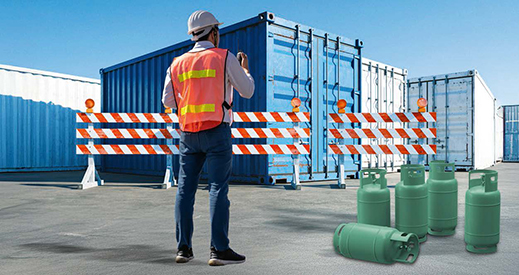This practice, which emerged strongly in 2018, is striking again with an increased resurgence in certain territories. Professionals in the HVACR sector must now be extra vigilant in order to work safely.
Entry routes constantly being identified
Illegal products mainly enter through the external borders of the European Union, particularly
via Eastern European countries, and are then transferred throughout the territory, as we regularly see in seizures reported by the trade press in our industry. These countries are most often transit zones rather than countries of origin, with production frequently located in Asia. Routes to market are also increasingly carried out via online platforms, sometimes concealed behind reputable supplier brands using counterfeit packaging.
Methods that evolve over time
To evade customs controls, “intermediaries” adapt their techniques and use their imagination to penetrate the market, for example by charging false deposits to conceal the packaging is nonreturnable or disposable, counterfeiting packaging from recognised brands, or using incorrect or inaccurate labelling, making detection difficult. An abnormally low price remains the first warning sign for buyers.
Using illegal refrigerant can have serious consequences
There are multiple risks at different levels:
- Safety: the lack of any guarantee as to the purity or composition of the product can lead to malfunctions, excessive energy consumption and even damage to equipment (blockages, pressure problems, leaks, breakages).
- Legal: the illegal importation of refrigerant is considered smuggling. The use of illegal refrigerant is considered receiving stolen goods, which is an administrative offence and may result in criminal penalties.
- Environmental: keeping high-GWP fluids in circulation runs counter to climate objectives and increases greenhouse gas emissions in the event of leaks.
A strengthening of the regulatory framework is currently being rolled out
The revision to the F-Gas III regulation includes new measures such as:
- A single European window to enable customs authorities to check importers’ quotas.
- Tighter restrictions on disposable packaging.
- A registration requirement even for products in transit.
These measures, which are still being rolled out, should improve traceability and reduce illegal
imports.
Collective initiatives to combat illegal trade
Dedicated working groups are being set up within various industry associations and organisations to take joint action against this problem and support refrigeration and air conditioning professionals. In particular, a technical guide is being finalised within the ADC3R (Association of distributors, fillers, recovery specialists and reclaimers of refrigerant in France) to clarify Articles 11.3 and 11.4 of the F-Gas III Regulation. These articles require packaging to be refillable and binding measures to be put in place to ensure its effective return, to avoid simple fictitious declarations. The aim is to provide a clear and harmonised framework so that all stakeholders comply with these obligations and help to limit the black market.
The short-term financial gain does not outweigh the human, technical, legal and environmental
risks associated with illegal trade. Purchasing and using compliant refrigerants protects your business, your customers and your technicians, and contributes to the transition to very low GWP solutions.

